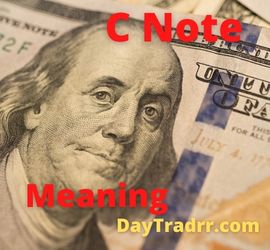What Is a C Note?
 The C note is an abbreviation for a $100 banknote in US currency. The “C” in C note alludes to the Roman numeral for 100. This upper-case C was printed on notes in the upper-left corner from 1869 to 1914. Also, C stands for a century which denotes a span of 100 years. The letter C also stands for “centum,” the Latin word for “one hundred.” The term note is derived from the bill itself. Printed directly on the US $100 bill is the phrase: “This note is legal currency for all debts, public and private.” The term C Note gained popularity in the 1920s and 1930s, and it was used in a number of gangster films.
The C note is an abbreviation for a $100 banknote in US currency. The “C” in C note alludes to the Roman numeral for 100. This upper-case C was printed on notes in the upper-left corner from 1869 to 1914. Also, C stands for a century which denotes a span of 100 years. The letter C also stands for “centum,” the Latin word for “one hundred.” The term note is derived from the bill itself. Printed directly on the US $100 bill is the phrase: “This note is legal currency for all debts, public and private.” The term C Note gained popularity in the 1920s and 1930s, and it was used in a number of gangster films.
The term C note is less commonly used in modern parlance and has been supplanted by a Benjamin. This term is derived from Benjamin Franklin, one of the United States’ founding fathers, whose face appears on the front of the $100 bill. Franklins, Bens, and Benjies are other colloquial terms for a US $100 note.
The Evolution The C Note
From 1869 through 1914, the US $100 note included a capital “C” in the upper-left corner. This C represents the Roman numeral for 100. In 1914, the United States government issued Federal Reserve notes to replace previous Treasury notes. Previous iterations of the US $100 Treasury Notes were very different from those available today. For example, on the left side of the 1878 and 1880 versions was a picture of Abraham Lincoln. The right side of the 1890 C note features Adm. David Farragut. The Farragut banknotes had two zeros that looked like watermelons on the backs, earning the nickname watermelon notes.
Contemporary $100 Bills
On the face of modern $100 notes is an enlarged portrait of Franklin, with the number 100 printed in each corner. The hue of the “100” in the bottom right corner varies depending on how the light hits it. A blue 3-D motion strip runs down the center to help prevent counterfeiting. Also, when the currency is held up to the light, a watermarked picture of Franklin emerges on the right side. Since 1969, the $100 bill has been the largest denomination available in US currency. Previous larger banknotes, such as the $500, $1,000, $5,000, and $10,000 bills, were discontinued.
The C Note, or $100 note, is one of only two US currencies produced today that do not depict a US president. The other is the $10 bill, which depicts Alexander Hamilton. The C note is also the only denomination today to include a structure or monument not located in Washington, D.C. Instead, on the reverse of a US $100 note is Independence Hall which is located in Philadelphia, Pennsylvania.
How long Does a C Note Stay in Circulation?
Paper currency eventually finds its way back to a Federal Reserve Bank through deposits. Once received, sophisticated processing equipment evaluates the quality of each note. To continue to circulate, notes must fulfill high-quality requirements and be in good shape. Those notes that do not comply are removed from circulation and destroyed. The life of a Federal Reserve note is determined by this procedure. The longevity of Federal Reserve notes varies per denomination and is determined by a variety of factors. A key wear factor is how the denomination is utilized by the general population. Larger denominations, such as $100 bills, are generally utilized as a store of value. This means they circulate less frequently than lesser denominations. For example, $1 bills and $5 bills are more commonly used for transactions. As a result, their lifespan in circulation is considerably shorter than a $50 or $100 note.
C Note Lifespan
If a $100 note remains in circulation, its expected lifetime is roughly 23 years. A $1 bill, on the other hand, has an average lifetime of only 6.5 years. It is believed that around 80% of the $100 notes in circulation circulate outside of the United States. In 2020, there were around 16.4 billion $100 notes in circulation, with a total value of approximately $1.64 trillion. There are around 13 billion $1 notes in circulation, which is less than the amount of $100 bills. Since 1995, the quantity of C-notes in circulation has more than quintupled – a five-fold increase. It is believed the growth in the use of $100 notes is due to a growing distrust of the financial system. Apparently, more people want to retain their assets outside of the financial system.
The Federal Reserve System regulates the distribution of $100 notes. This is because the demand for this denomination of cash fluctuates. Demand spikes over the winter holidays and the Lunar, or Chinese, New Year. This is because a crisp, new C note makes an excellent gift inside a greeting card or red gift envelope. When the new $100 bills were released in 2013, 28 reserve bank cash offices stocked up on 3.5 billion of the banknotes. As the revised C Notes entered circulation for the first time, those banknotes were distributed to over 9,000 banks.
What other Americans are featured on U.S. Currency?
George Washington is on the $1 bill, Thomas Jefferson is on the $2 bill, Abraham Lincoln is on the $5 bill, Alexander Hamilton is on the $10 bill, Andrew Jackson is on the $20 bill, Ulysses S. Grant is on the $50 bill, and Benjamin Franklin is on the $100 dollar.
Several denominations of currency notes are also no longer issued. The $500 bill features a portrait of William McKinley, the $1,000 bill features a portrait of Grover Cleveland, the $5,000 bill features a portrait of James Madison, the $10,000 bill features a portrait of Salmon P. Chase, and the $100,000 currency note features a portrait of Woodrow Wilson.
Why is Benjamin Franklin on a C Note?
Portraits of living people are not permitted to feature on Government Securities under current legislation. As a result, the pictures on US banknotes feature deceased historical people whose positions in history the American people are familiar with. The fundamental face and back designs of all denominations of US paper currency in circulation today were chosen in 1928. However, they were updated and enhanced to increase counterfeit protection beginning in 1996. Those decisions were taken by a committee formed to investigate the illegal reproduction of US paper currency. The Secretary of the Treasury generally chooses the designs seen on US money. Unless otherwise provided by a Congressional Act, the Secretary normally has the final say. However, this is done in collaboration and with the approval of authorities from the Bureau of Engraving and Printing (BEP).
According to the US Treasury, its records do not reveal why certain Presidents and historical figures were picked for specific dominions. There does not appear to be a clear set of criteria in the United States for determining who appears on coins and banknotes. In 1928, the fundamental designs for the front and back of all paper currency in contemporary circulation were chosen. Benjamin Franklin first featured on the $100 note in 1914. The picture of Benjamin Franklin is on the largest denomination note in circulation in the United States today, the $100 bill. The following are some of the reasons he is memorialized on the banknote.
Benjamin Franklin on the C Note
- Founding Father – Franklin was one of the country’s most important founding fathers. His contribution to the creation of the Declaration of Independence is seen as vital in the formation of the nation. Therefore, it is only natural that his portrait appears on some denomination of US currency.
- French Diplomacy – Franklin successfully secured the French backing for the colonists’ aspirations for independence. His efforts amounted to tens of thousands of francs paid on behalf of the future United States. Furthermore, the French contributed men and instruction to the colonial enterprise. As a result, Franklin’s role in getting French funds made the creation of the United States and its currency a reality.
- American Values – Franklin made significant contributions to what is considered most “American” about the United States. He was a restless innovator, a bold and skilled leader, as well as a diplomat and a smart man. All of these ideals are held dear by Americans. And, they are reflected in the iconic image of Benjamin Franklin as depicted on the US $100 note.
Up Next: What Are Naked Calls in Options Trading?
 Naked calls are a type of option speculation strategy where an investor writes (sells) a call option without owning the underlying security.
Naked calls are a type of option speculation strategy where an investor writes (sells) a call option without owning the underlying security.
This strategy is also known as an uncovered call or an unhedged short call. It differs from a covered call strategy in which the investor owns the underlying securities on which the call options are issued. In this regard, a naked call is similar to a naked put. The naked call method is potentially quite dangerous. If the option is exercised, the investor must then purchase the option’s underlying stock at the current market price. Stock prices, by definition, have no upper limit. This means that if the option is exercised, the investor could ultimately lose a considerable amount of money.




